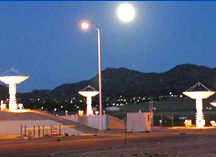The next time a nuclear detonation occurs in space or in Earth’s atmosphere, enlisted men and women in US Air Force ground stations will be the first to know.

As data from dozens of satellites flood into their control rooms, it will be these operators’ jobs to decide quickly whether to refer the event to higher-ups as a violation of international law or to designate the event as something less nefarious — a lightning strike or, perhaps, a satellite sensor glitch.
The snap decisions they make could trigger an international diplomatic crisis or, if they are wrong, result in an embarrassing false alarm.
Fortunately, the data will be processed, and their decisions simplified, by ICADS — the Integrated Correlation and Display System, created for the Air Force by Sandia.
ICADS is a key part of the US Nuclear Detonation (NuDet) Detection System (USNDS), a network of Global Positioning System and Defense Support Program (DSP) satellites, multiple detectors on board each satellite, and a handful of fixed and mobile ground stations.
“In some scenarios a nuclear proliferator or terrorist group might detonate a device in a way that makes it difficult to assign blame,” says John Williams, Sandia senior manager for USNDS Program Office 5740.
In that case, he says, US policy makers would need accurate real-time information about the time, location, yield, and any other evidence available via USNDS.
With budding nuclear programs in at least two nations — Iran and North Korea — USNDS may be called upon at any time to gather the facts about a modern nuclear detonation that could change the course of history (see “Sandia has long history supporting USNDS” at right).
“USNDS may be more important than ever to strategic national security,” says Jerry McDowell, VP for Defense Systems & Assessments. “The threats are real, and USNDS provides critical global awareness.”
Real-time reporting
ICADS includes the antennae, hardware, and software that help gather, correlate, and make sense of USNDS satellite data.
The system allows operators to quickly compare live satellite signals with hundreds of event profiles in its event database. Certain atmospheric phenomena — lightning, solar storms, and even pings to a satellite by energetic micrometeorite particles — can cause energy disturbances that register on the sensors.
“This is a complex, data-rich environment,” says John. “It would take a very long time to integrate, correlate, and assess the signals from dozens of sensors. But US decision makers need answers immediately. The analysis provided by ICADS before an operator ever sees the data helps make real-time interpretation possible.”
When a signal is verified by detectors aboard multiple satellites and bears the pulse waveform signature characteristic of a nuclear event, the operators refer the event up the national command structure, including the US State Department.
Rare commitment
Last year Sandia delivered ICADS IIF, the latest USNDS military ground station system, including more than a million lines of custom software code and an emphasis on human-computer interface, which makes the job of interpreting ICADS data more intuitive. (IIF signifies the next generation of GPS satellites; the first GPS IIF bird is scheduled for launch in 2009.)
The $188 million Sandia ICADS IIF program was unusual in its size and complexity. It was delivered fully qualified, under budget, and on time based on a delivery date set half a decade earlier — a rarity for a large military software development program, says Sandia ICADS project manager Don Rountree (5740).
“A program this complex is almost expected to fall behind schedule,” says Jerry. “To keep the promise we made back in 2000 required an incredible level of dedication by hundreds of people.”
The program also required a broad spectrum of Sandia expertise, he says, from atmospheric phenomenology and high-energy physics to software development and systems engineering.
24/7 support
Sandians continue to support the USNDS program. Technical experts at Sandia and Los Alamos national labs are on pager call around the clock to assist the Air Force with satellite and ground station troubleshooting.
They also provide second opinions regarding Air Force analysis of “zoo events” — unusual data signatures that don’t match existing event profiles. And Sandians train the Air Force ICADS trainers, who in turn train the ICADS operators.
In addition, under NNSA nonproliferation funding, Sandia is working on the next generation of lighter-weight, smaller global burst detectors to fly aboard the GPS IIF and a planned new series of DSP and GPS III satellites. Continued ICADS development to support the new satellite systems is under way as well.
“USNDS is a long-term commitment for us,” says John.